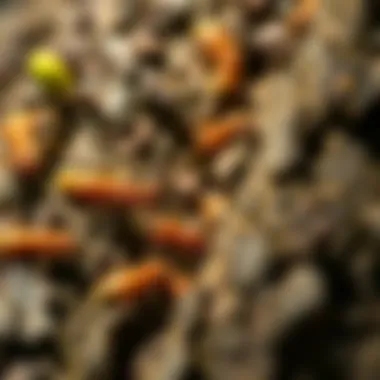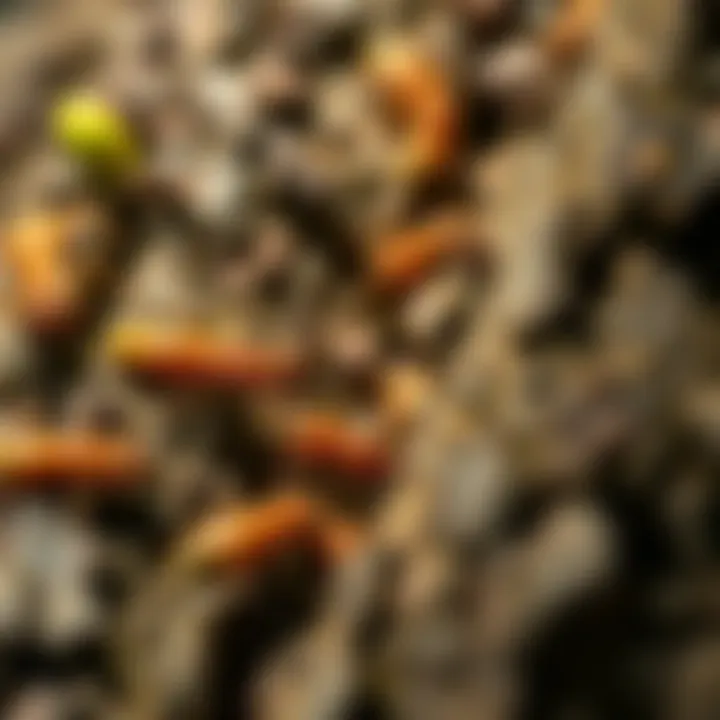Woodland Exterminator: Insights into Pest Management


Intro
In the heart of our woodlands, the balance between nature and human activities often confronts challenges stemming from pest populations. Woodland exterminators play a critical role in maintaining this balance. Their work is not just about eliminating unwanted critters; it involves understanding the nuances of the woodland ecosystem, dealing with unique pest species, and navigating the complexities of sustainable practices. Through this guide, we'll delve into the intricate world of forest pest management, encompassing identification, prevention strategies, and control methods, all designed to respect and restore the natural harmony of these settings.
Understanding the Pest
Identification
When it comes to pest management, knowledge is power. Identifying the specific pests that haunt woodland areas is the first step towards addressing any infestation. Common woodland pests range from the sprawling and destructive gypsy moth to the elusive and persistent woodboring beetle. Many species can cause significant damage to trees, plants, and even disrupt bird populations, thereby altering entire ecosystems. The key to successful pest control lies in the ability to recognize these pests accurately and swiftly.
Some telltale signs include:
- Visual Inspection: Look for signs of damage such as holes in leaves or bark. The presence of frass (insect droppings) can also indicate an infestation.
- Behavior: Observing pest behavior, like caterpillars feeding during the day or swarms typically seen at dusk, can lead to quicker identifications.
- Sound: Some pests produce distinct noises; for instance, woodborers make a faint crunching sound as they tunnel through wood.
Life Cycle
Understanding the life cycle of pests is equally vital. Each pest species has its own unique life cycle phases—egg, larva, pupa, and adult. For example, the gypsy moth goes from egg to larva in early spring, growing and feasting on foliage before entering the pupal stage. Knowing when pests are most vulnerable helps prioritize control measures effectively. Educating community members and woodland users on these cycles ensures proactive measures can be taken before populations explode.
Preamble to Woodland Extermination
In the heart of nature, woodlands stand as intricate ecosystems teeming with life. However, these vibrant habitats are not immune to pests. Woodlands often present unique challenges when it comes to pest management. An educator from a nearby university remarked, "Managing pests in these environments asks for creativity and thorough understanding, unlike urban spaces where treatment options are abundant." This highlights the significance of woodland exterminators who bridge the gap between ecological preservation and pest control.
Defining Woodland Exterminator
A woodland exterminator specializes in managing pests that threaten the ecosystem of forested regions. These professionals often operate in a distinct realm compared to typical pest control services. Unlike those that primarily handle urban or residential environments, woodland exterminators must have an in-depth knowledge of the complex interactions within forest habitats. They know that every action has a ripple effect. For instance, if they target beetles that are damaging trees, they also consider how this may impact birds that feed on those insects.
This nuanced approach is essential because it ensures that pest control methods do not inadvertently harm beneficial species or disrupt the ecological balance. An exterminator in the New England region pointed out, "Our work requires us to think like a naturalist, not just an exterminator. It’s a fine balance between intervention and letting nature take its course."
Importance of Pest Control in Woodland Areas
Pest control in woodlands goes beyond just eliminating annoying critters; it's about maintaining the health and diversity of the ecosystem. Pests like the emerald ash borer or certain types of invasive caterpillars can wreak havoc on local flora, leading to broader consequences such as loss of habitat for wildlife, reduced biodiversity, and even changes in soil health. Without effective management, a few pests can escalate into larger infestations that endanger the entire woodland environment.
Considerable benefits arise from effective pest management in these areas; the latent potential for thriving wildlife populations and plant communities is immense. A well-managed woodland not only supports diverse species but also enhances recreational areas for hiking, bird watching, and educational activities. The decline of tree species due to pest damage foreshadows an unfortunate future where those activities are diminished.
To support this perspective further, studies, such as those listed on Britannica, highlight the essential relationships within ecosystems and the critical role that pest management plays in sustaining them. As the old saying goes, "A stitch in time saves nine." Addressing pest issues swiftly can prevent significant challenges down the line, ensuring that woodlands remain robust and bountiful for future generations.
The Ecosystem of Woodlands
Understanding the ecosystem of woodlands is crucial to appreciating the role of pest management in these settings. Woodlands are not merely collections of trees; they are vibrant communities teeming with life and complexity. This intricate balance involves interactions between various species and environmental factors, all of which influence how pests thrive or are controlled. The health of this ecosystem directly affects the success of pest extermination efforts. A nuanced understanding of this ecosystem assists exterminators, homeowners, and local communities in implementing more effective and sustainable pest management strategies.
Characteristics of Woodland Habitats
Woodland habitats are defined by a variety of factors, both biotic and abiotic. These areas feature dense tree cover, which varies significantly depending on the geographical location and climatic conditions. The understory, or the layer beneath the canopy, is often rich with shrubs, small trees, and a diverse array of plants that contribute to the overall biodiversity.
- Canopy Layer: Tall trees form a roof over the woodland, creating a unique environment that shelters various species.
- Understory Layer: This layer is vital for many insect populations, providing habitat for both pests and beneficial insects.
- Forest Floor: Decomposing organic matter here enriches the soil, supporting plant life and influencing which pests might appear.
- Microclimates: Variations in humidity, temperature, and light create different niches for organisms within the woodland.
A deeper understanding of these layers and their characteristics helps exterminators identify which areas may be prone to pest infestations. For example, pests often find favorable conditions in damp understories or in the leaf litter on the forest floor. By studying these specific habitats, pest control professionals can target their efforts more effectively.
Biodiversity and its Impact on Pest Control
Biodiversity within woodlands plays a critical role in regulating pest populations. A rich variety of species—from birds to insects—contributes to a balance that can either keep pest numbers in check or lead to outbreaks when disrupted.
- Predators: Certain birds and beneficial insects act as natural pest controllers. For instance, ladybugs and lacewings feast on aphids, a common pest in woodland environments.
- Competition: Diverse plant species can compete with pests for resources, inhibiting their growth and reproduction.
- Resilience: Ecosystems with high biodiversity can recover more quickly from pest infestations or other disruptions.
"A flourishing woodland isn’t just a picturesque view; it's a battleground where nature’s own soldiers keep pest forces at bay."
Communities and exterminators must recognize the intricate ties between biodiversity and pest dynamics when developing management strategies. Maintaining natural habitats can promote a self-regulating ecosystem, which ultimately supports long-term solutions to pest problems in woodlands.


Common Pests in Woodland Environments
Understanding the common pests in woodland environments is essential for both managing pest populations and preserving the delicate balance of these ecosystems. Often, the types of pests found in these areas can significantly impact flora, fauna, and human activities. By recognizing these pests, we can adopt targeted strategies for pest management that minimize ecological disturbances while effectively maintaining harmony in woodland settings.
Types of Pests Found in Woodlands
Woodlands are home to a remarkable variety of pests that can pose challenges to forestry, agriculture, and even residential areas bordering these natural habitats.
- Wood-Boring Insects: These pests, like the emerald ash borer and the western pine beetle, feast on tree trunks and roots. Their tunnels weaken the trees, making them more vulnerable to disease and environmental stresses.
- Leaf-Cutting Ants: Although they are vital in nutrient cycling, these ants can devastate native plants. They collect leaves to cultivate fungi, which become their food source, leaving trails of defoliated vegetation in their wake.
- Ticks and Mosquitoes: Often regarded as nuisances, these blood-feeding arthropods can also be vectors for diseases like Lyme disease and West Nile virus. Their proliferation in wooded areas can become a public health concern.
- Rodents: Species such as deer mice and eastern chipmunks can cause damage to seedlings and compete with other wildlife for food resources. Their habitation within woodlands may also bring them into closer proximity with human dwellings.
Recognizing these specific pests is crucial for strategizing appropriate control measures. Each species requires a tailored approach to prevent overpopulation without upsetting the ecological balance.
Life Cycles and Behavior of Key Pests
Understanding the life cycles and behaviors of these pests provides insight into optimal timing for intervention. For instance,
- Emerald Ash Borer begins its life as an egg laid in the bark of ash trees in late spring. Once hatched, the larvae burrow under the bark to feed, which can lead to tree mortality if not controlled.
- Western Pine Beetles typically flourish in stressed trees, often during drought conditions, making these beetles a significant threat during specific climatic cycles.
- Leaf-Cutting Ants exhibit a diverse caste system, where worker ants are responsible for leaf collection, while others tend to the fungi gardens they cultivate. Understanding this behavior highlights the need for holistic pest management approaches that consider their ecological roles.
- Ticks undergo several life stages (larva, nymph, adult) that significantly affect their behaviors and host preferences. For instance, nymph ticks tend to be more active during warmer months, raising the need for preventive measures during this time.
By grasping the intricacies of these life cycles and behaviors, pest management efforts can be more precisely timed and executed.
The key to effective pest control in woodlands lies not just in removal but in understanding the natural processes at play. Successful pest management must balance control efforts with the preservation of woodland integrity.
In summary, common woodland pests and their life cycles are integral to understanding the broader challenge of pest management within these environments. Addressing such issues holistically ensures both human and environmental health are safeguarded.
Extermination Techniques Specific to Woodlands
In the realm of pest management, understanding the unique environment of woodlands is key. These areas, brimming with diverse flora and fauna, present distinct challenges and opportunities for pest control specialists. Utilizing appropriate extermination techniques is not just about eliminating pests; it is also about maintaining a delicate balance within the ecosystem. Here, we delve into various methods suited specifically for woodland environments, illustrating their significance and application.
Traditional Pest Control Methods
Traditional pest control methods have been utilized for ages, drawing on time-honored techniques adapted for woodland settings. These methods often include:
- Manual Removal: One can find physical removal quite useful in the woodland context. For example, clearing out nests of wasps or removing caterpillars from overhanging branches can effectively reduce pest populations without impacting other wildlife. This approach demands patience and practice but permite direct control over pest numbers.
- Traps: Using traps has long been a staple in pest management. In wooded areas, employing stick traps or bait traps can capture invasive species like the Asian hornet or certain beetles. It’s a non-toxic way to manage pests that also keeps other wildlife unharmed.
- Organic Chemicals: When necessary, utilizing substances that are derived from natural sources, such as neem oil, can deter pests. These treatments are less likely to upset the ecosystem balance, meaning beneficial insects can often remain unaffected.
Despite their effectiveness, traditional methods necessitate thorough understanding to ensure they do not harm other organisms or the environment itself. Proper timing and location can be make or break for traditional pest control strategies.
Innovative Solutions in Pest Management
As the world of pest control evolves, so too do the strategies used to combat pests in woodlands. Innovative solutions are increasingly emerging, reflecting advancements in technology and a growing emphasis on sustainability:
- Biological Control: This method employs natural predators to manage pest populations. For example, introducing ladybugs to combat aphid infestations helps keep pest numbers down naturally, supporting the local biodiversity.
- Integrated Pest Management (IPM): IPM combines various strategies to achieve long-term pest management. Instead of relying on a single pesticide, this system integrates cultural, biological, and chemical practices. For instance, planting diverse crops can disrupt pest lifecycles and reduce infestation rates.
- Smart Traps and Sensors: With the advent of technology, smart traps have come into play. Using sensors that detect pest presence and communicate data in real-time allows for timely interventions. This is incredibly efficient in large woodland areas where tracking pest populations manually is cumbersome.
- Drone Surveillance: Drones are becoming valuable tools in pest management. They provide the capacity to survey extensive woodland areas, spotting potential pest infestations from above. Having a bird's eye view can help focus extermination efforts precisely where they are needed.
"Investing in innovative methods not only improves pest control but also fosters a healthier woodland ecosystem."
These techniques encourage a conscious approach to pest control that preserves the richness of woodland environments. By employing both traditional and innovative methods, woodland exterminators can effectively manage pests while protecting the intricate balance of ecosystems that woodlands represent.
Sustainable Practices in Woodland Extermination
Sustainable practices in woodland extermination go beyond just mitigating pest issues; they create a harmony between human intervention and the natural ecosystem. As woodlands are vital components of our environment, the methods used to control pests must balance efficacy with ecological sensitivity. It’s not merely about getting rid of the pests, but ensuring the long-term health of the woodland environment. Understanding this delicate balance can be the key to effective pest management while preserving the natural landscape for generations to come.
The importance of adopting sustainable practices cannot be overstated. When sustainable methods are in play, they tend to reduce the adverse effects commonly seen with traditional extermination techniques. For instance, harmful chemicals can leach into the soil and water, affecting both plant and animal life. Sustainable practices aim to minimize these impacts, promoting healthier ecosystems. An eco-friendly approach not only allows for the natural predators of pests to thrive but also encourages biodiversity, which is essential for the resilience of woodland environments.
Benefits of Sustainable Extermination Techniques
- Reduced Chemical Use: Limiting the application of synthetic pesticides decreases the chances of pollution and harmful side effects on non-target species.
- Long-Term Solutions: Emphasizing prevention and natural control methods leads to enduring pest management efficacy.
- Community Engagement: Educating local homeowners about sustainable practices can foster a sense of responsibility towards nature. Understanding the local ecosystem is as important as recognizing the pests in one's backyard.
Eco-Friendly Pest Management Strategies


When dealing with pests in woodland settings, eco-friendly strategies can make a significant difference. These strategies focus on prevention and management rather than eradication. Some common eco-friendly pest management practices include:
- Cultural Control Measures: This involves adjusting agricultural practices to make the environment less hospitable to pests. For instance, rotating crops or planting pest-resistant plant varieties can deter specific pest populations.
- Biological Control: Utilizing beneficial insects like ladybugs or lacewings can help control pest populations naturally, providing a cost-effective and environmentally-friendly measure.
- Mechanical Exclusion: Barriers such as nets and traps can physically prevent pests from causing damage without resorting to chemicals.
Additionally, home composting not only enriches the soil but also attracts beneficial organisms that can aid in pest management. Educating communities on how to create and maintain a healthy soil environment ultimately supports the overall integrity of the woodland ecosystem.
"Think globally, act locally" is a mantra for sustainable practices, emphasizing how local actions can have a global impact.
Role of Beneficial Insects
The role of beneficial insects in pest management within woodlands cannot be understated. These little helpers can aid in the control of various pest populations through natural predation and competition. By understanding the specific beneficial insects in an area, woodland exterminators can promote an integrated pest management strategy that resonates well with the ecosystem.
Prominent Beneficial Insects:
- Ladybugs: Known for their appetite for aphids, these insects can significantly reduce pest numbers if established in a woodland.
- Praying Mantises: They consume various pest species, providing a natural balance within the habitat.
- Nematodes: These microscopic roundworms can target and control specific pest larvae in the soil.
To enhance the presence of beneficial insects, simple practices like planting a diverse array of flowers can create habitats that attract these organisms. By fostering an environment that promotes their reproduction and survival, homeowners can set the stage for natural pest management.
Legal and Ethical Considerations
The landscape of pest management in woodland areas is governed by a complex set of legal and ethical frameworks. These regulations and ethical norms are crucial for ensuring that pest control practices do not disrupt the delicate balance of the woodland ecosystem or harm non-target species. Understanding these elements is paramount for exterminators, homeowners, and community stakeholders engaged in pest management.
Several facets reinforce the importance of adhering to these legal and ethical considerations:
- Environmental Protection: The legal frameworks are often put in place to protect the environment from harmful practices. Many countries and regions have laws that restrict the use of specific chemicals and pesticides, ensuring that the natural habitat remains unspoiled. These regulations help preserve local biodiversity and maintain healthy ecosystems.
- Public Health: Pest control involves safeguarding public health alongside environmental concerns. Regulations help prevent the spread of diseases associated with pests, providing a structured approach to managing potential health risks to humans and animals alike.
- Accountability: By adhering to regulations, exterminators are held accountable for their actions. This creates a responsibility to use safe and effective methods while respecting community values regarding wildlife.
- Sustainability Goals: As society moves towards more sustainable practices, understanding legal guidelines helps integrate these ideals into pest control efforts. This means exterminators can adopt eco-friendly methods while still complying with necessary legislation.
Legal and ethical considerations in pest management are not mere bureaucratic hurdles; they form the foundation of responsible practice that ensures long-term ecological health and community well-being.
Regulations Governing Pest Control in Woodlands
The legal landscape of pest control encompasses numerous regulations designed to protect both the environment and public health. Different regions will have specific statutes, but several common elements typically stand out:
- Registration and Licensing: Exterminators often need to be licensed and their products registered for use in that locale. This involves demonstrating knowledge about the safe application of pesticides and the associated risks.
- Pesticide Use Restrictions: Many areas enforce restrictions on certain chemicals, particularly in sensitive habitats. These rules aim to prevent the contamination of soil and water and to protect non-target organisms that play crucial roles in the ecosystem. For instance, products like glyphosate are closely monitored due to their broad spectrum of activity and potential environmental impact.
- Documentation and Reporting: Professionals in pest management are usually required to keep records of their pesticide applications. This ensures traceability and accountability, offering insights into established patterns of pest control within regions.
- Local Ordinances: Some municipalities have local bylaws that further dictate practices in pest management. These can include restrictions on timing, methods, and types of pest control tools used.
Laws may vary widely, so it’s crucial for exterminators to stay informed about both regional and national regulations.
Ethical Responsibilities of Exterminators
Exterminators hold an important responsibility not only to their clients but to the broader community and ecosystem. Ethical practices in pest management include:
- Prioritizing Non-Toxic Methods: Whenever possible, exterminators should consider using non-toxic or less harmful methods to manage pest populations. This includes physical traps, natural repellents, or biological control options, which afford protection to beneficial species and reduce chemical dependency.
- Educating Clients: Ethical exterminators should educate clients about the implications of their pest management choices. This involves discussing potential non-target effects and exploring alternative solutions that align more closely with sustainable living principles.
- Respecting Wildlife: Compliance with wildlife protection laws is essential, especially in sensitive woodland settings. Exterminators need to be familiar with the wildlife regulations specific to their area so they can avoid negative impacts on endangered species or important habitats.
- Transparency: Open lines of communication with clients about methods, costs, and expected outcomes create trust and lead to more informed decisions about pest management.
Taking these responsibilities seriously fosters a better relationship with the environment and promotes responsible pest management practices.
For additional information on regulations and practices, check out these resources:
Understanding both legal and ethical frameworks ensures that pest management aligns with broader community and ecological goals, fulfilling the dual objectives of control and conservation.
Community Awareness and Engagement
Community awareness plays a pivotal role in the efficacy of pest management strategies within woodland environments. Understanding the dynamics of this interaction highlights how local residents can actively contribute to maintaining a balanced ecosystem, and why their involvement is indispensable in pest control efforts. Public education acts as a bridge, linking knowledge and action, ultimately leading to healthier woodlands and informed communities.
Importance of Public Education on Pests
Educating the public about pests is more than just addressing the nuisance they might cause; it’s about fostering a community that is aware of the broader implications of pest infestations in woodlands. Knowledge is a powerful tool. When individuals—especially those living near or within woodland areas—are informed about pest types, their life cycles, and the risks they pose, they become proactive rather than reactive.


For instance, rather than waiting for an infestation to manifest, homeowners equipped with knowledge can identify the early signs of pest issues. This allows for rapid intervention, reducing the need for heavy-handed chemical treatments that can harm the environment. Public education initiatives can include:
- Workshops and seminars focusing on pest identification and management.
- Distribution of informative leaflets at local events that explain the role of various woody and plant-dwelling pests.
- Online resources, such as local government sites or educational platforms, providing up-to-date information and best practices.
In this digital age, utilizing social media platforms can also amplify educational efforts effectively. Engaging content on Facebook or local community forums can encourage residents to share experiences and solutions, fostering a greater understanding of pest management within their shared environment.
Encouraging Community Participation in Pest Management
Engaging the community in pest management strategies can significantly enhance the success of these initiatives. Collective participation nurtures a sense of responsibility and ownership among residents, which in turn promotes a culture of stewardship.
Encouraging communities to take part can manifest in several ways, such as:
- Community clean-up days: Organizing events to clear litter and debris, which can serve as homes for pests. Keeping environments tidy can deter pests naturally.
- Adoption of integrated pest management (IPM) principles: Through community workshops, residents can learn about eco-friendly pest control methods that rely on natural predators and habitat modification.
- Citizen science projects: Involving locals in tracking pest populations or monitoring wildlife can engage them further in preserving their woodlands. For example, residents might report sightings of particular pests, which can help track their spread.
- Establishing local gardening groups: These groups can share techniques on creating pest-resistant landscapes, integrating native plants that can naturally deter unwanted guests while enhancing biodiversity.
Community-driven initiatives not only enhance pest management effectiveness but also promote neighborly interactions, combined efforts, and a deeper connection to their natural surroundings.
"Alone we can do so little; together we can do so much." - Helen Keller
Combining education with active participation empowers communities to shape their relationship with their environment meaningfully. Therefore, fostering an engaged community is critical not only for the present but also for the future of woodland ecosystems.
Future Trends in Woodland Pest Management
In contemporary discussions on pest management, the focus is shifting toward how emerging technologies and ecological considerations can reshape our approach to woodland extermination. The unique environment of woodlands poses both challenges and opportunities when it comes to managing pests effectively. As stewards of these vital ecosystems, it's crucial to remain informed about the latest trends that can enhance pest management strategies while maintaining ecological integrity.
Emerging Technologies in Extermination
The evolution of technology has brought forth innovative solutions in pest control that can significantly benefit woodland environments. Here are a few remarkable technologies:
- Drone Surveillance: Drones equipped with cameras can cover vast woodland areas quickly, providing real-time views of pest outbreaks. This aerial perspective allows exterminators to pinpoint problem areas effectively without disturbing the ecosystem.
- Biological Control Agents: Advances in genetic engineering are enabling the development of pest-resistant strains of flora that can thrive in woodlands. For example, specific plants may be genetically modified to produce natural pesticides, combating pests naturally while preserving the surrounding flora and fauna.
- Smart Traps: Enhanced trap systems that utilize sensors can automatically monitor pest populations. These traps can notify exterminators of the detected pests, allowing for a timely response without constant human oversight.
Incorporating such technologies not only increases efficiency in extermination but also minimizes human intervention in delicate woodland ecosystems.
Predictions for Woodland Ecology and Pest Dynamics
As we move forward, we can anticipate several important shifts in woodland ecology that will affect how pests interact with their environment. Key predictions include:
- Climate Change Impacts: With climate patterns evolving, many pests might adapt to new conditions, such as warmer winters enabling insects to survive longer. This can lead to an increase in pest populations that previously struggled to thrive in cooler climates.
- Loss of Biodiversity: Ongoing threats to biodiversity, due to urban expansion and pollution, could tip the balance in pest dynamics. As natural predators decline, the control over pest species may become more challenging, necessitating new management strategies.
- Community Involvement in Pest Monitoring: The trend toward increased community awareness can play a crucial role in monitoring pest dynamics. Local individuals equipped with knowledge about native species and changes in pest behavior can contribute valuable data to pest management programs.
Understanding these predictions allows woodland exterminators to adapt their strategies accordingly, utilizing both technology and community support for sustainable pest management solutions.
"In our ever-changing world, staying a step ahead with emerging trends is not just beneficial; it's essential to the health of our woodlands and the balance we strive to maintain."
These future trends clearly highlight the importance of not only embracing technological advancements but also recognizing the shifts within ecological dynamics that inform our pest management practices.
By integrating responsible techniques and fostering community involvement, we can pave a path for effective pest control in woodlands, ensuring that these invaluable ecosystems remain resilient and thriving for generations to come.
Finale
In examining the role of woodland exterminators in pest management, it becomes evident that a nuanced understanding of both the ecosystem and the specific pests involved is crucial. This conclusion encapsulates the significance of the insights discussed throughout this article, shedding light on various aspects that warrant attention for both pest management professionals and property owners alike.
Summary of Key Insights
Throughout our exploration, several critical insights have emerged:
- Unique Challenges: Woodland environments present distinct challenges compared to urban or agricultural settings. The mosaic of habitats, along with high biodiversity, makes pest control more complex. Understanding the ecological dynamics is paramount for effective management.
- Diverse Pest Species: From wood-boring beetles to invasive plant species, the variety of pests encountered in woodlands necessitates tailored approaches to extermination. Familiarity with the life cycles and behaviors of these organisms aids in developing effective control strategies.
- Eco-Friendly Methods: The necessity for sustainable practices in pest management is a recurring theme. Techniques such as integrated pest management (IPM) and the promotion of beneficial insects not only address pest issues but also contribute positively to the ecosystem as a whole.
- Community Involvement: The importance of community awareness cannot be overstated. Educated property owners who understand pest dynamics and management strategies foster healthier woodland spaces and contribute to overall ecosystem health.
The Path Forward for Woodland Extermination
Looking ahead, several considerations emerge for enhancing pest management practices in woodland areas:
- Adopting New Technologies: Emerging innovations, such as biopesticides and smart traps, hold promise for improving efficiency and reducing environmental impact. Encouraging research and development in these areas can lead to more effective solutions.
- Legislation and Policy Update: As pest populations evolve, so too must the laws and regulations governing pest management. Continuous dialogue among exterminators, environmentalists, and policymakers is vital to ensure that pest control practices evolve to meet changing ecological conditions.
- Community Collaboration: Engaging local communities in woodlands not only raises awareness but also fosters cooperative management efforts. Collaborative approaches can enhance the effectiveness of pest control measures while promoting ecological literacy among residents.
- Education and Training: Continuous training for exterminators on the latest pest management strategies, environmental laws, and community engagement techniques can equip professionals to handle challenges in woodland management competently.
In summary, the future of woodland extermination hinges on flexibility, education, and community involvement. By embracing sustainable practices and advancing technologies while fostering robust community ties, we can ensure that woodland environments remain vibrant and resilient against the challenges pests present.







